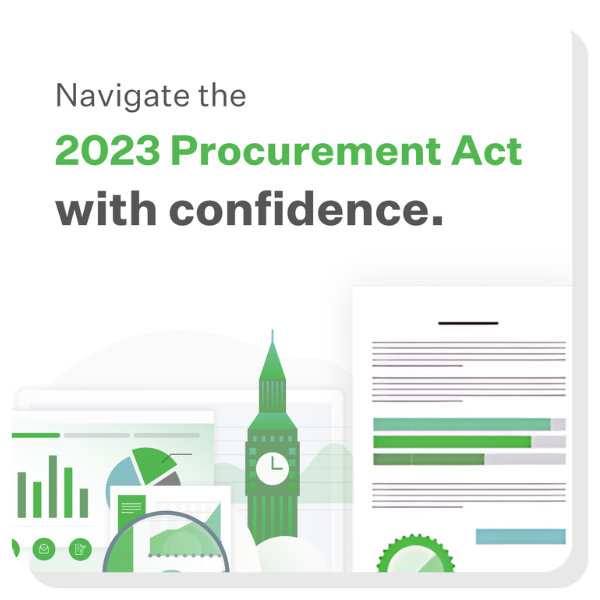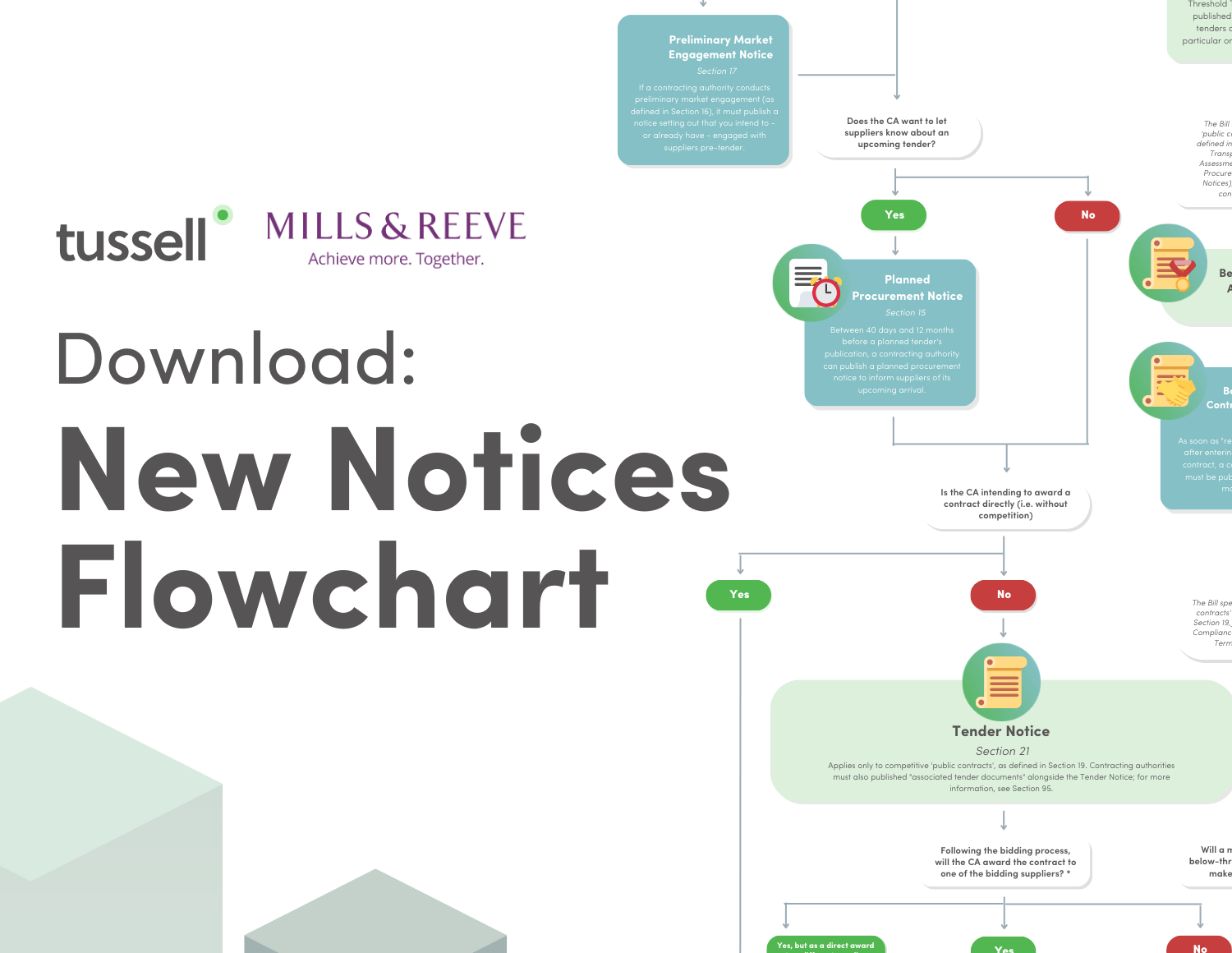In February 2025, the Cabinet Office published Procurement Policy Note (PPN) 001 which mandates new targets for direct SME and VCSE spending across Central Government.
With SME and VCSE participation also a high priority for NHS and Local Government procurement teams, this blog provides 10 actionable tips for how you can increase the number of SMEs and VCSEs bidding and winning work with your authority.
Skip ahead to read about:
- Engage with the market early and often
- Break contracts into smaller lots
- Promote consortia and subcontracting
- Improve the visibility of opportunities
- Build supplier capacity
- Embed social value into evaluation criteria
- Monitor and report on SME and VCSE spend
- Improve feedback for unsuccessful bidders
- Consider routes to market carefully
- Set aside procurements for SMEs and VCSEs
*
Access the industry benchmark on public sector SME spending: Tussell and the British Chamber of Commerces' 2024 SME Procurement Tracker.
🙋 1 - Engage with the market early and often
One of the most effective ways buyers can boost engagement and competition from SMEs and VCSEs is by proactively engaging the market well before the formal procurement process begins.
Inviting SMEs and VCSEs to preliminary market engagements isn't just good practice - it’s a catalyst for inclusivity, innovation and better value.
By engaging small suppliers early in the process, procurement teams can incorporate their insights and ensure SMEs are well-positioned to compete effectively when the contract goes to tender.
Other pre-tender market engagements can also be useful for smaller suppliers.
Pipeline notices and planned procurement notices can increase participation of suppliers of all sizes by providing greater visibility and notice of upcoming procurements.
✂️ 2 - Break contracts into smaller lots
Large, bundled contracts often favour big suppliers and can be difficult for SMEs and VCSEs to bid for.
Where appropriate, de-scoping or dividing contracts into smaller lots can enable smaller organisations to compete effectively.
This is particularly useful for services that can be geographically or thematically segmented, as many SMEs & VCSES operate locally and are unable to provide services on a regional or national level.

See where you rank in Tussell's Local Government Procurement Index
Whilst breaking up contracts risks adding complexity, this can be offset by using lead providers or consortia (see Tip 3) to handle coordination. This lead provider model can also mitigate the risk of fragmentation and increase the quality and consistency of contract delivery.
💼 3 - Promote consortia and subcontracting
Forming a consortium can be an effective way for smaller organisations to pool resources and expertise to meet the demands of larger or more complex contracts. However, many VCSEs and SMEs are unfamiliar with the legal, organisational, and practical aspects of consortium working.
Without targeted support, these groups may shy away from collaborating, missing out on opportunities they could otherwise deliver collectively.
By offering clear, practical guidance on forming and managing consortia, contracting authorities can build confidence, demystify the process, and encourage inclusive bidding behaviour.
Specific examples of guidance may include:
-
Step-by-step toolkits on forming consortia;
-
Consortium agreement template documents;
-
FAQs covering common questions around bid coordination;
-
Guidance on how to write a consortium bid;
-
Case studies of consortia that have successfully bid for and delivered public contracts.
🔎 4 - Improve the visibility of opportunities
Smaller contracts are rarely subject to the same publishing requirements as larger ones, even though smaller contracts are the very opportunities that SMEs and VCSEs are best positioned to win!
By ensuring all opportunities - regardless of size - are clearly advertised on platforms like Contracts Finder and relevant portals, SMEs and VCSEs are more likely to encounter relevant opportunities and submit a bid.
Clear contract titles, avoiding jargon, and consistent CPV code usage are also important. Smaller firms with limited bidding teams have less time to trawl tender portals. So, the easier your opportunity is to find, the more likely SMEs and VCSEs will engage.
🔎 5 - Build supplier capacity
Many SMEs and VCSEs struggle not because they lack the ability to deliver services, but because they lack procurement-specific knowledge: how to write a strong bid, interpret contract documents, or respond to evaluation criteria.
Building supplier capability is not only an investment in more competitive and inclusive tendering, but also improves the quality and diversity of the supply chain over time.
Specific actions to build supplier capacity may include:
-
Hosting bid-writing workshops;
-
Providing training on public procurement fundamentals;
-
Creating materials - or directing new suppliers towards existing materials - demystifying common terms like MAT, frameworks, DPS, PQQs, and more;
-
Developing template responses for common bid sections;
-
Providing pre-procurement health checks to help smaller suppliers understand Cyber Essentials, data protection, and other common compliance requirements.
-1.png?width=450&height=330&name=Procurement%20Act%20Hub%20Graphics%20(1)-1.png) Access Tussell's Procurement Act Hub for buyers' and suppliers' training resources
Access Tussell's Procurement Act Hub for buyers' and suppliers' training resources
Public sector buyers can amplify their reach and impact by partnering with local business support organisations, VCSE infrastructure bodies, or chambers of commerce.
For example, Manchester City Council works closely with the Greater Manchester Chamber of Commerce to run “meet the buyer” events and supplier training sessions targeting SMEs across the region.
🌱 6 - Embed social value in evaluation criteria
For most buyers, social value must account for at least 10% of the total bid evaluation - but remember, this is the floor, not the ceiling!
VCSEs often deliver exceptional social value as part of their core mission -whether that’s supporting disadvantaged groups, creating inclusive jobs, promoting mental health, reducing environmental impact, or delivering services in under-served areas.
However, these contributions can be overlooked if social value is either underweighted or vaguely assessed.
When it comes to choosing assessment criteria, buyers might consider using the TOMs or the Central Government Social Value Model as a framework to score suppliers on local spending, inclusive economic growth, or other criteria likely to advantage small businesses and VCSEs.
📈 7 - Monitor and report on SME and VCSE spend
PPN 001 requires Central Government contracting authorities to measure and report direct spending with SMEs and VCSEs. Whilst optional for other public sector buyers, measuring the success of SME and VCSE engagement initiatives is impossible without doing so.
Tussell's market intelligence platform is the public sector's preferred method of monitoring SME and VCSE procurement spend.
Used by Central Gov't, Local Gov't, NHS and Education buyers across the country, Tussell helps procurement teams measure and benchmark spending with SMEs, VCSEs and local suppliers.
Tussell's best-in-class public sector market intelligence platform empowers buyers to break down spending by category, supplier, and time period, and build data-driven plans to boost VCSE engagement.
To learn how we can help you, book a chat with the Tussell team.
🗣️ 8 - Improve feedback for unsuccessful bidders
For many SMEs and VCSEs, especially those new to public sector procurement, the experience of submitting a bid can be resource-intensive and daunting.
When they are unsuccessful, a generic or vague rejection - such as "you were not the highest scoring bidder" - does little to help them improve or return in future rounds.
Providing clear, constructive, and tailored feedback is one of the most effective ways to build supplier capability over time. It increases transparency, builds trust in the process, and enables small and mission-led organisations to learn, develop, and compete more successfully in future.
🛣️ 9 - Consider routes to market carefully
Not all routes to market are inclusive for SMEs and VCSEs.
Traditional closed frameworks - for example - provide fewer opportunities than open frameworks for newer, smaller suppliers to join. If you want to use a framework for your procurement, a dynamic market or open framework could be a more SME-friendly alternative.
Even beyond the structural differences between different framework types, specific frameworks can be more or less SME-friendly based on how difficult it is for SMEs and VCSEs to fulfil the framework joining criteria.
Tussell is the only public sector market intelligence tool that matches call-offs to specific frameworks.
To conduct detailed analysis on which frameworks are actually being used to award contracts to SMEs and VCSEs in your category, or to quickly compare live frameworks you can use right away, book a chat with the Tussell team.
💸 10 - Set aside procurements for SMEs and VCSEs
Under the 2023 Procurement Act, buyers have new powers to reserve specific procurements for VCSEs, SMEs and local suppliers.
In Tussell's First 30 Days | Procurement Act Webinar with the Cabinet Office and the CMA, we used data from Tussell's market intelligence platform to show how over 5% of FTS notices in the first 4 weeks after the Act went live referred to procurements reserved for VCSEs and/or SMEs.
If you're not already reserving opportunities for SMEs and VCSEs, this is one of the easiest, most straightforward ways of growing your SME and VCSE supplier base.
🌅 Conclusion
Tussell and the British Chamber of Commerce's SME Procurement Tracker found that only 20% of direct public sector procurement spending goes to SMEs.
Additional research from Tussell and Cardiff University shows that the figure for small and micro firms is even lower.
With a renewed government focus on social value and the introduction of SME and VCSE spending targets, there has never been a better time to focus efforts on increasing SME and VCSE engagement.
Tussell is already connecting Central, Local and NHS procurement teams with SMEs, VCSEs and local businesses with a track record of working in the public sector.
Book a chat with the Tussell team to learn how you can start turning insight into impact.



![[Gov] New Nav Bar, Solutions - DSIT citation v1, Rounded](https://www.tussell.com/hubfs/%5BGov%5D%20New%20Nav%20Bar%2c%20Solutions%20-%20DSIT%20citation%20v1%2c%20Rounded.png)
![New Nav Bar - New Tag [Gov]](https://www.tussell.com/hubfs/New%20Nav%20Bar%20-%20New%20Tag%20%5BGov%5D.png)

![[Gov] New Nav Bar, Insights - SS Report v1, Rounded](https://www.tussell.com/hubfs/%5BGov%5D%20New%20Nav%20Bar%2c%20Insights%20-%20SS%20Report%20v1%2c%20Rounded.png)






.png?width=815&height=200&name=TUSSELL_Demo_CTA_Banners%20(14).png)
.png?width=815&height=200&name=TUSSELL_Demo_CTA_Banners%20(16).png)
-1.png?width=815&height=200&name=TUSSELL_Demo_CTA_Banners%20(2)-1.png)
-2.png?width=815&height=200&name=TUSSELL_Demo_CTA_Banners%20(1)-2.png)

.png?width=815&height=200&name=TUSSELL_Demo_CTA_Banners%20(17).png)

.png?width=815&height=200&name=TUSSELL_Demo_CTA_Banners%20(15).png)


